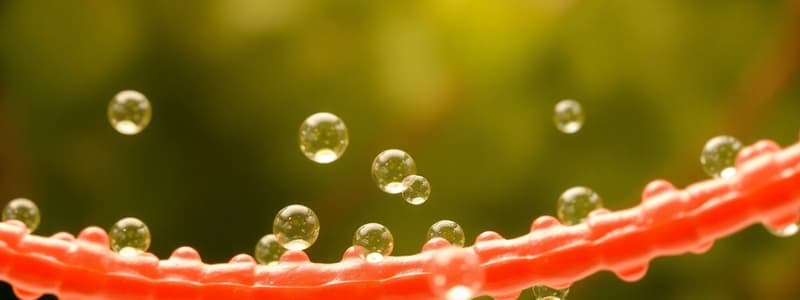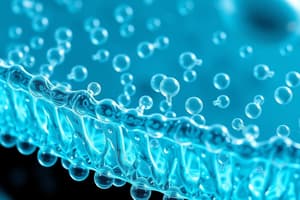Podcast
Questions and Answers
Hydrophilic molecules are unable to form hydrogen bonds with water.
Hydrophilic molecules are unable to form hydrogen bonds with water.
False (B)
Membranes surrounding cells and organelles are primarily composed of lipids, proteins, and a significant amount of carbohydrates.
Membranes surrounding cells and organelles are primarily composed of lipids, proteins, and a significant amount of carbohydrates.
False (B)
Phospholipids, glycolipids, and sterols are the four major classes of lipids found in cell membranes.
Phospholipids, glycolipids, and sterols are the four major classes of lipids found in cell membranes.
False (B)
The permeability of a membrane to a molecule is solely determined by the molecule’s charge.
The permeability of a membrane to a molecule is solely determined by the molecule’s charge.
Integral proteins are easily isolated from the cell membrane due to their hydrophilic regions.
Integral proteins are easily isolated from the cell membrane due to their hydrophilic regions.
Peripheral proteins are typically embedded within the lipid bilayer of a cell membrane.
Peripheral proteins are typically embedded within the lipid bilayer of a cell membrane.
The main function of transport proteins in cell membranes is to provide structural support to the membrane.
The main function of transport proteins in cell membranes is to provide structural support to the membrane.
Receptor proteins on cell membranes are involved in enzymatic activities.
Receptor proteins on cell membranes are involved in enzymatic activities.
The rate of simple diffusion of a molecule across a membrane depends on its size and how hydrophobic or hydrophilic it is.
The rate of simple diffusion of a molecule across a membrane depends on its size and how hydrophobic or hydrophilic it is.
Active transport moves molecules from an area of higher concentration to an area of lower concentration, requiring energy in the form of ATP.
Active transport moves molecules from an area of higher concentration to an area of lower concentration, requiring energy in the form of ATP.
Direct active transport uses the energy released by an endothermic reaction to transport molecules across the cell membrane.
Direct active transport uses the energy released by an endothermic reaction to transport molecules across the cell membrane.
Endocytosis is the process by which cells secrete bulk material by enclosing it in vesicles that fuse with the plasma membrane.
Endocytosis is the process by which cells secrete bulk material by enclosing it in vesicles that fuse with the plasma membrane.
Simple diffusion requires the expenditure of energy by the cell.
Simple diffusion requires the expenditure of energy by the cell.
In simple diffusion, molecules move against the concentration gradient.
In simple diffusion, molecules move against the concentration gradient.
Osmosis refers to the diffusion of water across a selectively permeable membrane from a region of higher solute concentration to lower solute concentration.
Osmosis refers to the diffusion of water across a selectively permeable membrane from a region of higher solute concentration to lower solute concentration.
Facilitated diffusion requires energy from ATP for molecules to move down their concentration gradient.
Facilitated diffusion requires energy from ATP for molecules to move down their concentration gradient.
Channel proteins must bind to the molecule they are transporting to facilitate its movement across the cell membrane
Channel proteins must bind to the molecule they are transporting to facilitate its movement across the cell membrane
The selectivity of ion channels is primarily based on the presence of hydrophobic amino acids and the size of the pore.
The selectivity of ion channels is primarily based on the presence of hydrophobic amino acids and the size of the pore.
Channel proteins remain permanently open to allow continuous passage of ions.
Channel proteins remain permanently open to allow continuous passage of ions.
Carrier proteins facilitate transport by forming channels through the membrane.
Carrier proteins facilitate transport by forming channels through the membrane.
Flashcards
What are hydrophilic molecules?
What are hydrophilic molecules?
Molecules that can easily form hydrogen bonds with water and dissolve in it.
What are cell membranes composed of?
What are cell membranes composed of?
Lipids such as phospholipids, glycolipids, and sterols; proteins; and a small amount of carbohydrates.
What is the importance of lipid bilayers as barriers?
What is the importance of lipid bilayers as barriers?
They regulate molecule movement. Nonpolar molecules like oxygen and CO2 are permeable, while ions like Na+, K+, H+, and Cl- are impermeable.
What are integral membrane proteins?
What are integral membrane proteins?
Signup and view all the flashcards
What are peripheral membrane proteins?
What are peripheral membrane proteins?
Signup and view all the flashcards
What are transport proteins?
What are transport proteins?
Signup and view all the flashcards
What is active transport?
What is active transport?
Signup and view all the flashcards
What are endocytosis and exocytosis?
What are endocytosis and exocytosis?
Signup and view all the flashcards
What is simple diffusion?
What is simple diffusion?
Signup and view all the flashcards
What is osmosis?
What is osmosis?
Signup and view all the flashcards
What is facilitated diffusion?
What is facilitated diffusion?
Signup and view all the flashcards
What are channel proteins?
What are channel proteins?
Signup and view all the flashcards
What are carrier proteins?
What are carrier proteins?
Signup and view all the flashcards
Study Notes
- Water is a polar molecule that can bond with other molecules, facilitating dissolution and is termed hydrophilic.
- Hydrophobic molecules cannot form hydrogen bonds.
- These bonds are fundamental for cell structure.
- Membranes that surround cells and organelles act as barriers that control exchange.
- Membranes comprise lipids (phospholipids, glycolipids, sterols), proteins, and small amounts of carbohydrates.
Lipid Bilayer Composition
- The three major classes of lipids include phospholipids, glycolipids, and sterols like cholesterol.
- Phospholipids are the most abundant lipids.
- A phospholipid molecule consists of a glycerol backbone.
- Attached to the backbone is composed of a phosphate molecule liked to choline or serine forming a hydrophilic head group.
- Also attached are two nonpolar fatty acid chains that form hydrophobic tails.
- Tails of fatty acids can be saturated or unsaturated.
- Phospholipids organize with hydrophobic tails away from water, forming two lipid bilayers.
Lipid Bilayers as Barriers
- They occur in almost all biological membranes, regulating the movement of substances.
- Molecules such as nonpolar, oxygen, nitrum (N2), and CO2 are permeable.
- Water and glycerol are mostly permeable.
- Glucose and sucrose are mostly impermeable.
- Molecules such as Na+, K+, H+, and Cl- are impermeable.
- Membrane permeability to molecules depends on their size and hydrophilic/hydrophobic nature.
Membrane Proteins
- Membrane proteins are classified as integral or peripheral.
- Integral proteins are difficult to isolate and interact with the hydrophobic interior of the lipid bilayer, embedding them in the bilayer.
- Peripheral proteins are hydrophilic and located on the membrane surface, interacting with hydrophilic regions of integral proteins.
Functions of Membrane Proteins
- Transport proteins facilitate the movement of molecules in and out of the cell, including channel proteins.
- Recognition proteins aid in cell-cell recognition, essential for the immune system.
- Receptors receive chemical signals.
- Enzymes catalyze enzymatic activities and reactions.
Selectivity in Membrane Permeability
- The movement of molecules by simple diffusion depends on their size and hydrophilic nature, determining membrane permeability.
- Facilitated diffusion and active transport use proteins to move molecules across the membrane.
- These transport proteins selectively recognize specific molecules or classes of molecules.
- Selective permeability results from facilitated diffusion and active transport.
Transport Across Membranes: Active Transport
- Active transport moves molecules from lower to higher concentration regions, requiring energy (ATP).
- Pump proteins move ions or molecules against their concentration gradient.
- It helps in the uptake of essential nutrients.
- It helps in the removal of secretory or waste materials from the cell.
- It helps maintaining correct ion concentrations in the cells.
Types of Active Transport
- Direct active transport uses energy from exergonic reactions like ATP hydrolysis to transport molecules.
- Vesicles transport large amounts of material.
- Endocytosis moves particles into the cell where the cell membrane engulfs particles.
- Phagocytosis ingests large solids.
- Pinocytosis ingests liquids.
- Phagocytosis involves the membrane surrounding, engulfing, and transporting particles with a phagosome to the lysosome.
- Pinocytosis involves the cell taking in small amounts of extracellular fluid.
- Exocytosis is the reverse; it secretes bulk material.
- The to-be-removed material is enclosed in vesicles that fuse with the plasma membrane.
Passive Transport: Simple Diffusion
- Simple diffusion moves molecules down a concentration gradient (high concentration to low concentration).
- It's a spontaneous process (can lead to equilibrium) that doesn't require energy.
- Gas exchange: red blood cells transport oxygen from the lungs to body cells.
- Oxygen diffuses in the alveoli down the concentration gradient to blood in capillaries.
- Oxygen is carried to tissues, where it diffuses from high to low concentration areas.
- The same process occurs with carbon dioxide.
Osmosis
- It occurs with diffusion of water across a selectively permeable membrane from lower to higher solute concentrations.
- Solute concentration is higher inside the cell, leading to net water movement into the cell.
- Permeability depends on the size and polarity of molecules.
Facilitated Diffusion
- It involves the movement of solutes down their concentration gradient, mediated by carrier or channel proteins.
- The movement is facilitated by transport proteins.
Channel Proteins
- They are transmembrane proteins that form channels for polar molecules like ions.
- They are highly selective, with different channels needed for different ions.
- Ion channel selectivity is determined by the binding sites of hydrophilic amino acids and the size of the pore.
- Channels open and close in response to stimuli like voltage changes, binding of small molecules, or mechanical forces.
- When open, ions pass through the pore down the concentration gradient. When closed, the pore is plugged.
- Carrier proteins bind to solute molecules, undergo conformational changes, and transfer molecules across the membrane.
Studying That Suits You
Use AI to generate personalized quizzes and flashcards to suit your learning preferences.




